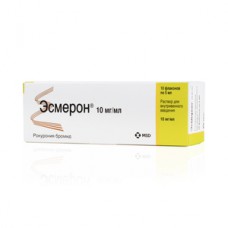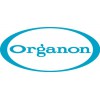Expiration date: 07/2026
Form of issue and composition:
Solution for injection 1 ml 1 FL.
rocuronium bromide 10 mg 50 mg
5 ml - bottles (12) - cardboard packs.
Solution for injection 1 ml 1 FL.
rocuronium bromide 10 mg 100 mg
10 ml - bottles (10) - cardboard packs.
Pharmacological action:
Non-depolarizing peripheral muscle relaxant of medium duration of action.
Fast. It has all the pharmacological effects (kurarepodobnymi), characteristic of this class of drugs. Blocks n-cholinergic receptors of skeletal muscles and prevents depolarizing action of acetylcholine. Antagonists of this action are acetylcholinesterase inhibitors type neostigmine, and pyridostigmine hidroponia.
Within 60 seconds after I/o administration of rocuronium bromide at a dose of 0.6 mg /kg of body weight (2 x ED90 with I/o General anesthesia), almost all patients achieve an adequate condition for intubation, and 80% of them have conditions for intubation regarded as excellent. The total relaxation of skeletal muscle, adequate for any surgical intervention, is achieved within 2 minutes. Clinical duration (time to spontaneous recovery of the contractility of skeletal muscles to 25% of the control level) at this dose is 30-40 minutes. The total duration (time to spontaneous recovery of skeletal muscle contractility up to 90% of the control level) is 50 min. the Average time of spontaneous recovery of contractility from 25 to 75% of the control level (recovery index) after administration of rocuronium bromide in a single dose of 0.6 mg / kg is 14 min.
The introduction of acetylcholinesterase inhibitors, such as neostigmine, pyridostigmine or edrophonium, suppresses the action of Esmeron.
Pharmacokinetics:
Distribution
After the on/in the introduction followed by rocuronium bromide, the change in its concentration in blood plasma is 3 the exponential phase to the period of poluraspredelenia 2 (±1) and 16 (±8) min.
Vss is 0.23 (±0.06) l / kg.
Breeding
T1 / 2 is 97 (±49) min, plasma clearance-3.9 (±1.3) ml / min / kg.
Within a few hours of bile excreted 30-40% of the drug unchanged.
With urine is deduced 13-30.8% of the total administered dose during the first 12 no.
It is assumed that in humans also plays an important role excretion through the liver.
After the introduction of Esmeron neither plasma nor urine failed to detect any metabolites of rocuronium.
Pharmacokinetics in special clinical cases
Controlled studies have shown that plasma clearance in patients of senile age and in patients with liver disease or renal dysfunction is slowed, but in most studies the observed differences did not reach a statistically significant level.
Factors that increase the circulation time of the drug in the blood (including cardiovascular disease, senile age and swelling), lead to an increase in Vd and may contribute to a later start of the drug.
Indications:
As an additional remedy for General anesthesia:
to ensure skeletal muscle relaxation during surgery
to facilitate tracheal intubation.
Dosage regimen:
The dose of Esmeron is selected individually, taking into account the method of General anesthesia, the expected duration of the operation, the possible interaction with other drugs administered before and/or during anesthesia, and the General condition of the patient. To assess the degree of suppression and recovery of neuromuscular reactions, it is recommended to use appropriate instrumental methods.
To facilitate tracheal intubation, Esmeron administered at a dose of 0.6 mg/kg. the recommended maintenance dose is 0.15 mg/kg, in the case of long-term inhalational anaesthesia it should be reduced to 0.075-0.1 mg/kg maintenance dose, it is best to enter at the time when the degree of muscle contraction is restored to 25% of the control level.
To relax the skeletal muscles during surgery, the drug is administered by continuous infusion. In this case, it is recommended to give a loading dose of 0.6 mg/kg, and when the relaxation of skeletal muscles begins to weaken, start infusion. The rate of administration should be chosen so that the contractile response of skeletal muscles was 10% of the control level. In adults, in/in General anesthesia, the infusion rate required to maintain muscle relaxation at this level is 5-10 µg / kg / min, and in inhalation anesthesia - 5-6 µg/kg/min. It is important to constantly monitor the condition of the neuromuscular system, as the required infusion rate may be different for different patients and different methods of anesthesia.
In patients with overweight or obesity (body weight 30% higher than ideal) dose should be reduced, counting on muscle mass.
The introduction of the intravenous solution
Studies have been conducted and it has been shown that at nominal concentrations of 0.5 mg/ml and 2 mg/ml Esmeron is compatible with 0.9% sodium chloride solution, 5% dextrose solution, 5% dextrose in saline solution, sterile water for injection, ringer solution and hemacel (Haemacce). The introduction should begin immediately after preparation of solution for infusions and finish within 24 hours any Unused solution should be discarded. Since Esmeron does not contain preservatives, the solution should be used immediately after opening the bottle.
Esmeron, you can enter through the system for on/in infusions with solutions of the following drugs for at/in the introduction: adrenaline, alkenone, Alfentanil, aminophylline, atracurium, atropine, ceftazidime, cefuroxime, cimetidine, clemastine, clindamycin, clomethiazole, clonazepam, clonidine, danaparoid, dobutamine, dopamine, dehydrobenzperidol, ephedrine, ergotamine, esmolol, etomidate, fentanyl, flucytosine, gallamine, gentamicin, dextrose 40%, glycopyrrolate bromide, heparin, isoprenaline, ketamine, labetalol, lidocaine, mannitol 20%, metoclopramide, metoprolol, metronidazole, midazolam, milrinone, morphine, nifedine, nimodipine, nitroglycerin, norepinephrine, oxytocin, pankuronia, pethidine, pipekuronia, potassium chloride, promethazine, propranolol, propofol, ranitidine, salbutamol, sodium carbonate, nitroprusside, Sufentanil, suxamethonium, and vecuronium verapamil and geoplasma and talamonal/
Side effect:
Perhaps the development of allergic reactions.
When prescribing Esmeron, it should be borne in mind that there are reports of the occurrence of anaphylactic reactions when using muscle relaxants. Although the use of Esmeron they are rare, you should prepare for the treatment of such complications, if they occur. Special precautions should be taken if the patient has a history of anaphylactic reactions to muscle relaxants, as described cross-allergic reaction to drugs in this group.
Since it is known that peripheral muscle relaxants can induce both local and systemic histamine release, the administration of these drugs should always take into account the possibility of itching or erythematous reactions at the injection site and/or generalized histamine-like (anaphylactoid) reactions, such as bronchospasm and changes in the cardiovascular system. Although with a rapid single administration of 0.3-0.9 mg of rocuronium bromide / kg body weight, there was a slight increase in average levels of histamine in plasma, clinically expressed tachycardia, hypotension or other clinical signs of histamine release with the introduction of Esmeron was not observed.
Contraindications:
history of anaphylactic reactions to rocuronium or bromine ions.
Pregnancy and lactation:
Data on the safety of Esmeron during pregnancy and lactation in humans are absent. The use of the drug is possible in cases where the expected benefit to the mother exceeds the potential risk to the fetus or child.
In experimental studies on animals to date, no negative effects of Esmeron during pregnancy have been found/
Special instruction:
Esmeron should be used in conditions that allow you to urgently stop anaphylactic reactions, if they occur. This is especially true for patients with a history of anaphylactic reactions to muscle relaxants, as described cross-Allergy when using drugs in this group.
Since Esmeron causes paralysis of the respiratory muscles, the use of the drug is absolutely necessary to conduct ventilation until adequate recovery of independent breathing.
With the use of Esmeron in doses greater than 0.9 mg / kg may increase heart rate. This effect can counteract bradycardia caused by other anesthetics or arising from vagus nerve stimulation.
Muscle relaxants should be administered in carefully selected doses, sufficient to maintain incomplete neuromuscular blockade. The introduction should be carried out by a doctor who has experience with muscle relaxants, or carried out under his supervision, as well as in conditions of adequate control of vital functions of the body.
Since Esmeron is always used simultaneously with other drugs, and during anesthesia, even in the absence of known provoking agents, the development of malignant hyperthermia is possible, clinicians should be familiar with the early manifestations, factors confirming the diagnosis, and methods of treatment of malignant hyperthermia before any General anesthesia.
Animal studies have shown that Esmeron is not a factor that provokes the development of malignant hyperthermia.
Since rocuronium is excreted in the urine (approximately 30% within 12-24 h) and it is assumed that it can be partially excreted also with bile, Esmeron should be used with caution in patients with clinically expressed liver and/or biliary tract diseases and/or renal insufficiency. In these groups of patients there was an elongation of the effect at doses of rocuronium bromide 0.6 mg/kg.
Like other muscle relaxants, Esmeron should be used with extreme caution in patients with diseases of the neuromuscular system or who have undergone polio, since the reaction to muscle relaxants in these cases can be significantly changed. The magnitude and direction of these changes can be very different.
During surgery on the background of hypothermia blocking effect of Esmeron on the neuromuscular system increases, and the duration of action increases.
In patients with obesity, Esmeron, like other muscle relaxants, can have a longer effect, and spontaneous restoration of the normal state of neuromuscular conductivity after administration of the drug may be longer.
The effects of Esmeron are enhanced by hypokalemia (eg, after severe vomiting, diarrhea or diuretic treatment), hypermagnesemia, hypocalcemia (after massive transfusions), hypoproteinemia, dehydration, acidosis, hypercapnia, cachexia. Given this, before applying Esmeron severe disorders of electrolyte balance, alteration of blood pH or dehydration should, whenever possible, to korrigirovat.
Overdose:
Symptoms: increased degree and duration of muscle relaxation.
Treatment should continue the ventilator, and at the beginning of the spontaneous recovery of respiration should be administered the adequate dose of acetylcholinesterase inhibitor (e.g. neostigmine, hidroponia, pyridostigmine). If the introduction of an acetylcholinesterase inhibitor does not remove the blocking effect of Esmeron, it is necessary to continue ventilation until independent breathing is restored. Repeated administration of an acetylcholinesterase inhibitor can be dangerous.
Drug interaction:
It is shown that the following drugs affect the strength and / or duration of non-depolarizing muscle relaxants.
Action Esmeron is enhanced by concomitant use with halothane, ether for anesthesia, enfluran, isoflurane, methoxyflurane, cyclopropane when administered in high doses, thiopental, methohexitone, ketamine, fentanyl, gamma hydroxybutyrate, etomidate and propofol in the case of the previous injection of suxamethonium with aminoglycoside and peptide antibiotics, antibiotics acylamino-penicillin with metronidazole at high doses, as well as with diuretics, beta-blockers, thiamine, MAO inhibitors, quinidine, Protamine, alpha-blockers, magnesium salts.
The action of Esmeron decreases while the use of neostigmine, edrofoniem, pyridostigmine, derivatives of aminopyridine in the case of prior long-term administration of corticosteroids, phenytoin or carbamazepine with noradrenaline, azathioprine (only temporary and limited effect), theophylline, calcium chloride.
When applied as a single dose netilmitina, cefuroxime, metronidazole and the combination of cefuroxime and metronidazole does not enhance the action Esmeron.
Pharmaceutical interaction
Installed physical incompatibility Esmeron when added to solutions containing the following drugs: amphotericin, amoxicillin, azathioprine, Cefazolin, cloxacillin, dexamethasone, diazepam, enoximone, erythromycin, famotidine, furosemide, hydrocortisone sodium succinate, insulin, methohexital, methylprednisolone, prednisolone sodium succinate, thiopental, trimethoprim and vancomycin. Esmeron is also incompatible with intralipid.
Terms and conditions of storage:
The drug should be stored in a dark place at a temperature of 2° to 8°C. Esmeron can be stored at 8-30°C for 12 weeks before the expiration date. Shelf life-3 years.


